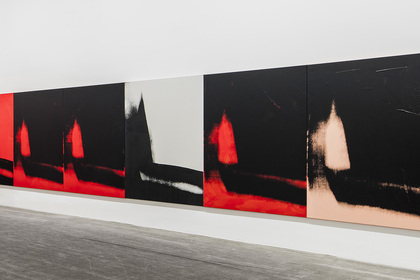-
From Current Issue
-
- Editor’s Letter Fire in the Heart
- Reviews I Gusti Ayu Kadek Murniasih
- Reviews 11th Seoul Mediacity Biennale: “One Escape at a Time”
- Dispatch Networked China
- One on One Monira Al Qadiri on Yukio Mishima
- Essays The rise of independent art spaces in pandemic-era Shanghai
- Features Tuan Andrew Nguyen
- Table of Contents
- Web Exclusives
- Archive
- Subscribe

R
E
V N
E
X
T
Installation view of ANDY WARHOL’s exhibition “Shadows” at Yuz Museum, Shanghai. Collection Dia Art Foundation, New York. Copyright The Andy Warhol Foundation for the Visual Arts, Inc./ Artist Rights Society (ARS), New York.
Featuring what is often touted as the worst if not the most enigmatic paintings of Andy Warhol’s late career, the highly anticipated exhibition “Shadows” is now on view at the Yuz Museum in Shanghai, organized in collaboration with the Dia Art Foundation in New York. Having previously toured to five other major international venues, including the Hirshhorn Museum and Sculpture Garden in Washington, DC, the Museum of Contemporary Art, Los Angeles, the Musée d’art moderne de Ville de Paris, and most recently the Guggenheim Museum Bilbao, this all-encompassing installation of 102 large silkscreen and acrylic paintings constitutes a second blockbuster show for the Yuz Museum within the past year, following the astounding Giacometti retrospective in March. “Shadows” isalso running concurrently with the thematic group show “Overpop,” curated by Jeffrey Deitch and Karen Smith, which focuses on an emerging generation of artists who are purportedly redefining the spirit of Pop Art in the post-internet age.
“Shadows” present a more metaphysical side of Warhol that is perhaps lesser known to general audiences. As with countless artists throughout history, the subject of shadows had long interested Warhol, who began a series of works based on this motif in 1978. Warhol directed one of his studio assistants to take photographs of ordinary shadows, and from there he selected what would be transformed into silkscreens—but nobody seems exactly certain as to what the shadows are of or how they were orchestrated. Some say they were derived from cardboard maquettes set up in Warhol’s office, while others hypothesize, rather dubiously, that they were erect penises that served as the basis for the two predominate and repetitive phallic shapes that appear throughout all 102 paintings. These shapes, one vaguely resembling a bishop’s hat that is referred to as “the peak” and the other a somewhat stubbier form known as “the cap,” are the work’s two primary compositional elements, grounded by a high-contrast, abstract field limited to 17 specific colors ranging from Day-Glo green, yellow, turquoise, scarlet purple and crimson to hot pink, cobalt blue, silver, a somber brown and black.
Warhol conceived Shadows as a single, monumental monochrome painting in 102 parts. The paintings hang edge-to-edge without space between them, like a gigantic wrap-around film strip that encloses the entire space and its visitors. Repetition and seriality was nothing new to Warhol. Since 1962, when he first exhibited his Campbell Soup can paintings and multiple portraits of Marilyn Monroe and other celebrities, Warhol understood the power of multiplicity better than anyone. He was 50 years old when he made Shadows, and he was certainly aware of other artists who had delved deeply into the subject—from Man Ray’s early 1919 photographic experiments to Rauschenberg’s “White Paintings” from the 1950s, the latter being a series of blank white canvases that are shadow-catchers in themselves, created as a way to simply experience the passage of time and light. Warhol always knew what was going on around him and paid close attention, particularly to his own peers, like Rauschenberg and Ellsworth Kelly, whom he admired. He surely knew of Kelly’s photographs of raking geometric shadows against walls and buildings along the streets of Paris, created when the elder artist was living there. Rauschenberg, too, was no stranger to mechanical reproduction or the use of solvent-transfer techniques, which he applied in creating images for his own works. Warhol kept a shrewd and unrelenting eye on the progress and success of his peers later in life, as much as he did when he was starting out, identifying the supermarket, daily tabloids, advertising, cinema and the discotheque as infinite source materials for his work.
Warhol is frequently cited as being dismissive about Shadows when he first saw it installed, where he commented: “The show only looks good because it’s so big.” He also referred to it as “disco décor.” But Warhol was habitually coy. And contrary to what some critics have said about Shadows being both Warhol’s swan song to a waning career toward the end of the 1970s, or some pretentious and vacuous last assault on Abstract Expressionism, they have it totally wrong. Warhol went on to make other significant abstract works up until the time of his death in 1987, such as the “Rorschach” paintings from 1984 and the “Camouflage” paintings made shortly thereafter. If anything, Shadows is not only “a monument to impermanence,” as New York Times critic Holland Cotter wrote in 2011, but it could also be read as a monumental elegy to a time when the advent of AIDS began to pummel the gay community in New York and to the darker days that followed. Those two flickering flame-like images that permeate throughout the surfaces of Shadows could be seen quite differently with this thought in mind.
Andy Warhol’s “Shadows” is on view at Yuz Museum, Shanghai, until January 15, 2017.
To read more of ArtAsiaPacific’s articles, visit our Digital Library.





